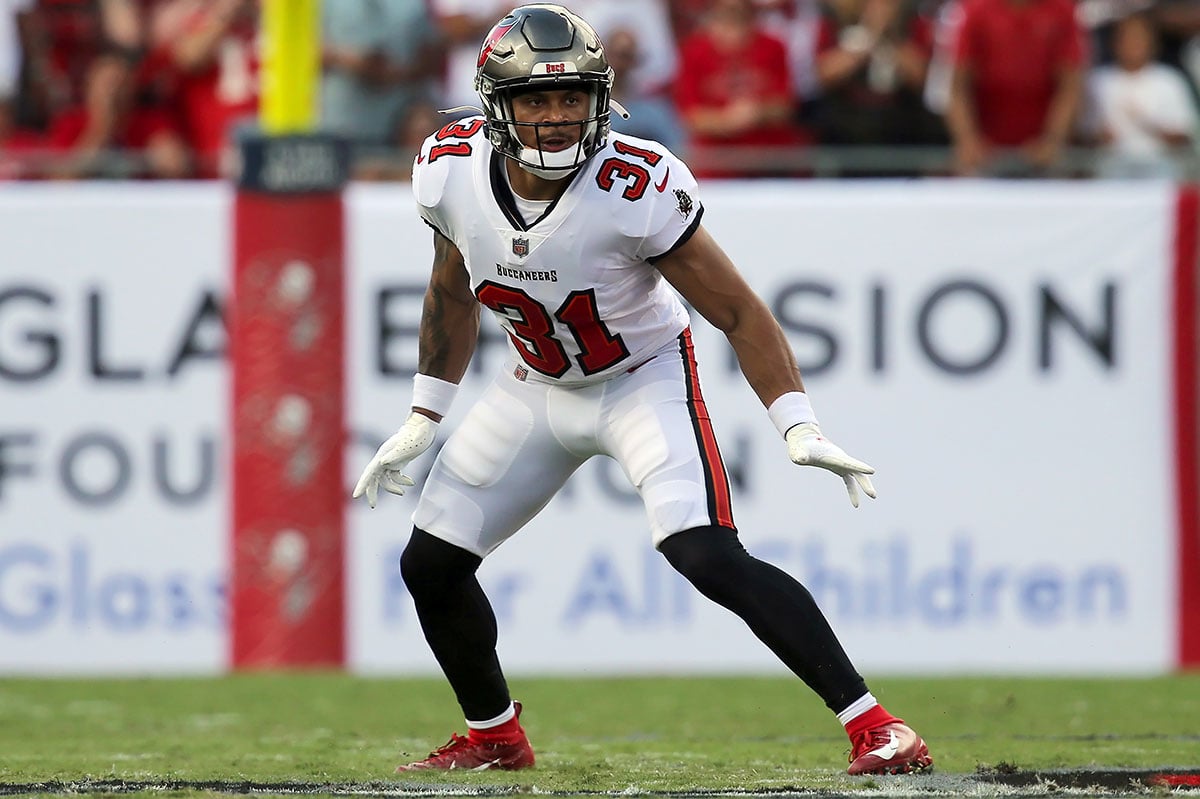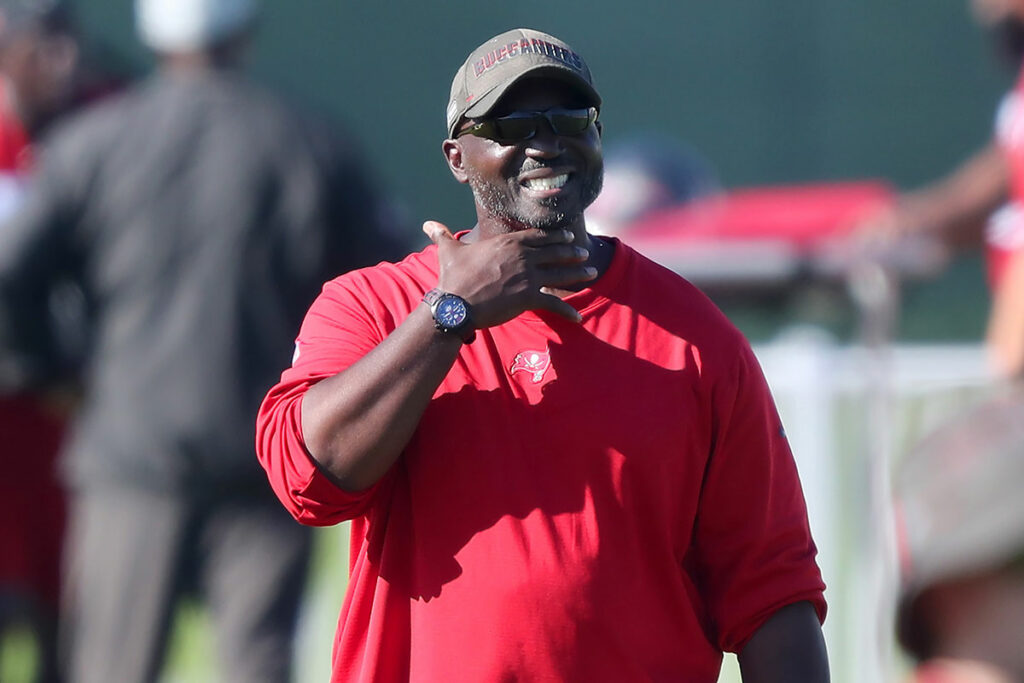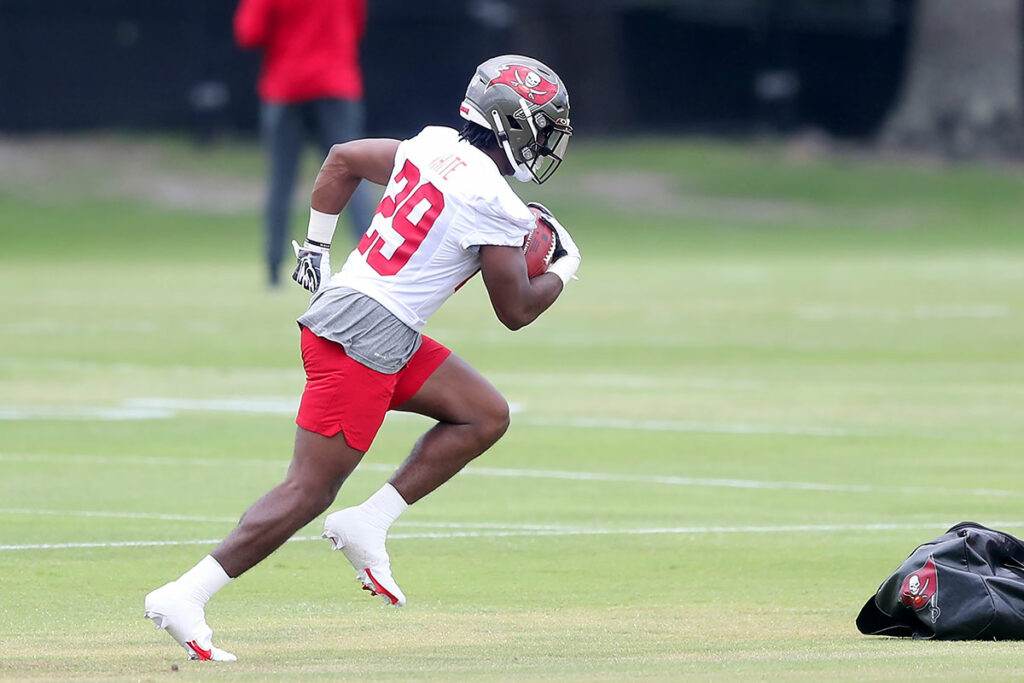Welcome back to another edition of “Grinding the Tape”. This week, we will take a look at another rising star for the Bucs, safety Antoine Winfield Jr.
Winfield is entering his third year in the league after being drafted in the second round of the 2020 NFL Draft. Over the course of his first two seasons, he has quickly established himself as one of the best coverage safeties in the game. In his young career, he has already logged 182 combined tackles, five tackles for loss, four forced fumbles, four fumble recoveries and three interceptions. In addition, he finished fourth in voting for AP Defensive Rookie of the Year in 2020 and earned his first Pro Bowl selection in 2021. He is a big reason why many analysts are so high on the Bucs secondary overall.
Winfield plays a crucial role in the Todd Bowles Cover-3 scheme. For the majority of snaps, he is the deep safety helping to ensure that big plays don’t happen. According to Pro Football Focus, Winfield lined up deep (as “Free Safety”) over 70% of the time in 2021. This allows Bowles to use his other safety on the field in a variety of ways. This includes bringing him into the box to establish numbers to stop the run.
So, what makes Winfield so great that allows him to unlock the Bucs’ defense? I endeavored to find out. I watched four games from last season for my evaluation: Week 1 against Dallas, Week 3 against the Rams, Week 5 against New England and Week 8 against New Orleans. Here are the four keys I found to his success:
Reading The Quarterback
One of the things that can make watching safeties – especially deep safeties – so frustrating is the lack of action on a play-to-play basis. There is a good number of snaps where they just aren’t involved in the play at all. Some of this comes from running plays that get stuffed relatively quickly before the high safety can get down to the line to help. Others are pass plays to the far side of the field. But in watching Winfield, I believe I have a newfound appreciation for a high-caliber safety not getting work. This comes from his ability to make quarterbacks just go away from his side of the field.
Many teams in the NFL are moving to more Cover-4 looks to prevent big plays. This has the defense drop four members of the secondary to deep zones to dissuade the offense from trying to push the ball downfield. The Bucs have not moved in this direction, instead keeping with their Cover 3/Cover 1 schemes. The potential weakness of this is that, if the offense sends two or more receivers on deep routes, one of those receivers is going to end up in single coverage. The key is for the deep safety to be able to read the play well enough to commit to the most likely route the quarterback wants to go to. Winfield is a master of this. That’s a big reason why the Bucs allowed the third-fewest plays of 40-plus yards last year, giving up just five.
Take a look at a few examples of this:
Watch as Winfield quickly moves to his right to cover up the free release of the slot receiver. At the same time, he is watching the quarterback. This allows him to read Mac Jones to see if he tries to push the ball to the outside receiver. If Jones does, Winfield can keep moving outside to effectively create a double on the pass. If Jones continues to look for the slot receiver, Winfield has him covered. All the while, Winfield is using his movement to push the slot receiver inside. Why? That’s where he has help from the dropping linebacker underneath and the additional defensive back over the top. Ultimately, Jones can’t find an option in either of those first two reads, holds onto the ball too long and gets eaten up by the pass rush.
On this next one, Winfield is again able to quickly read quarterback Trevor Siemian and shift to the side of the play of the quarterback’s initial read. He quickly covers up the tight end releasing deep and prevents the play from potentially becoming a chunk play. Siemian ultimately settles for the underneath route for a short five-yard gain.
Working Well In Space
Another area that contributes to Winfield being rated the second-best safety in the NFL last year by PFF (with a grade of 89.5) is his ability to understand the feel for zone coverage. He can pass off receivers with ease and understands how to move within his zone to cover players behind him who he can’t actually see. This gives him the ability to kill off would-be options in a quarterback’s progression.
Watch as Winfield is presented with two crossing routes converging just behind him. If he chooses to follow the wrong one, it can lead to an open receiver and a touchdown. But he knows the coverage and realizes that he has help from other Bucs defenders to his left. So, he lets the cross to his left release into that zone. Meanwhile, he chooses to pick up the cross moving to his right. He follows the receiver into open space and prevents him from coming open. Both of those crosses happened to his back. But he instinctively understood what was happening and made the right call.
Driving To Underneath Routes
This was the aspect of Winfield’s game I didn’t truly appreciate enough. His ability to sink his hips and drive forward from a backpedal allow him to explosively drive down on mesh routes, short crossers and slants with authority. He combines this athleticism with a rare understanding of route combinations to help him pick up routes he would normally have no business covering. There is no shortage of these plays on his tape in every game.
Against Dallas, Amari Cooper is given a free release out of the slot on a deep out. You can see Dak Prescott look to Cooper in his progression. But he opts to throw the ball to the outside receiver on the short hitch instead. This is, in large part. because Winfield was able to stop his drop and drive down on Cooper’s route so quickly.
Here, you see the same thing against Dallas tight end Dalton Schultz. Schultz is able to find some space up the seam initially. However, once he bends his route to the inside, Winfield is able to break quickly and chew up tons of ground. This takes Schultz out as an option for Prescott.
Here’s one more example, as this one especially stood out. This wasn’t a deep out where he had to cover a small amount of space. And this wasn’t an obvious route for Winfield to pick up either. This was Winfield working down from a very deep single-high placement and picking up a very shallow cross on a mesh concept. How he was able to diagnose the route concept and pick up the route so easily and so quickly really highlights what makes him special. And for good measure, here are two more examples against New Orleans:
Athleticism On Display
In previous editions of “Grinding the Tape,” I have noted that new safeties Keanu Neal and Logan Ryan lack some athleticism, which limits their games. That is not the case with Winfield. His explosiveness in and out of his cuts, as well as his backpedal, allow him to make some really fun highlight-reel plays.
You won’t find this play on Winfield’s stat sheet. Despite his superhuman efforts to cover the receiver and ultimately pick the ball off, the play was called back due to a roughing the passer call. But it doesn’t stop us from really seeing how fantastic of an athlete Winfield is. Look at what he had to deal with. With all of the space available, Winfield has to defend against what could be a two-way go. He has to be ready for both an outside and an inside break. The receiver uses this to his advantage, getting behind Winfield before ultimately breaking in. This creates the sliver of daylight the quarterback thinks will be an easy, wide-open touchdown. But Winfield is able to quickly recover and cut the ball off.
Here, against New England, Winfield lines up as a corner close to the line of scrimmage. As the ball is snapped, he is pushed back by the receiver trying to create as much room as possible for the back, who is getting the designed flat pass. Winfield is able to quickly diagnose the play, shed the block and move into position. This is all due to his athleticism, allowing him to explosively drive down on the running back. He finishes the play with a strong tackle that knocks the ball out for a fumble and a turnover for the Bucs.
Finally, against Dallas, you can watch as Winfield changes direction from his drop into a deep zone. He is able to move back toward the ball’s flight path with strength and lateral agility. This is why he’s able to help disrupt the pass at the catch point. This led to a Bucs interception and another turnover.
Do-It-All Safety
Winfield is the definition of a “do-it-all” safety. He has the highlight-reel plays due to a rare combination of athleticism and processing ability. He has the speed to be a single-high safety. The coverage abilities to play in the slot. But the one thing I don’t think he gets enough credit for is his ability to impact a play without being a direct part of it. He can take away large swaths of the field from a quarterback, forcing short throws underneath. No matter what he is doing, Winfield is a joy to watch.




